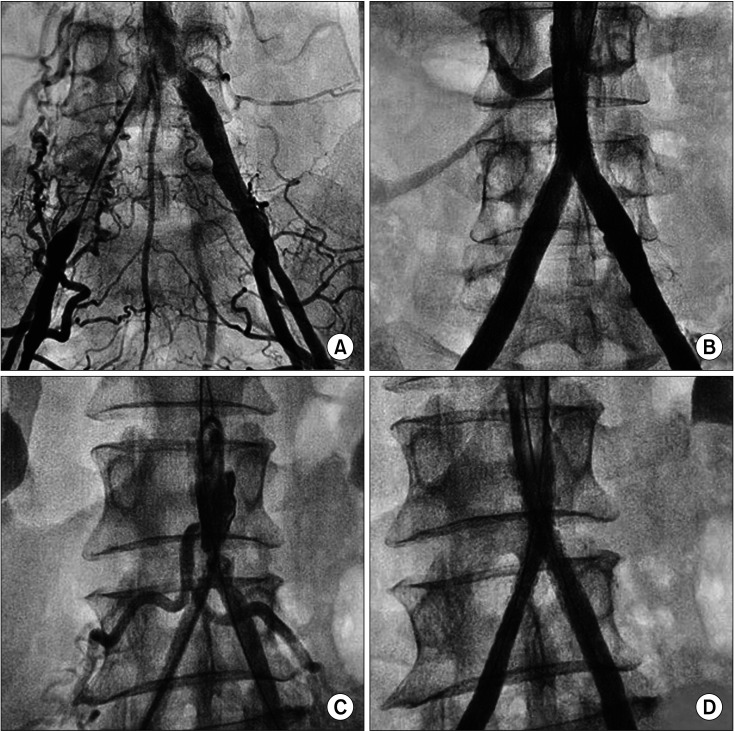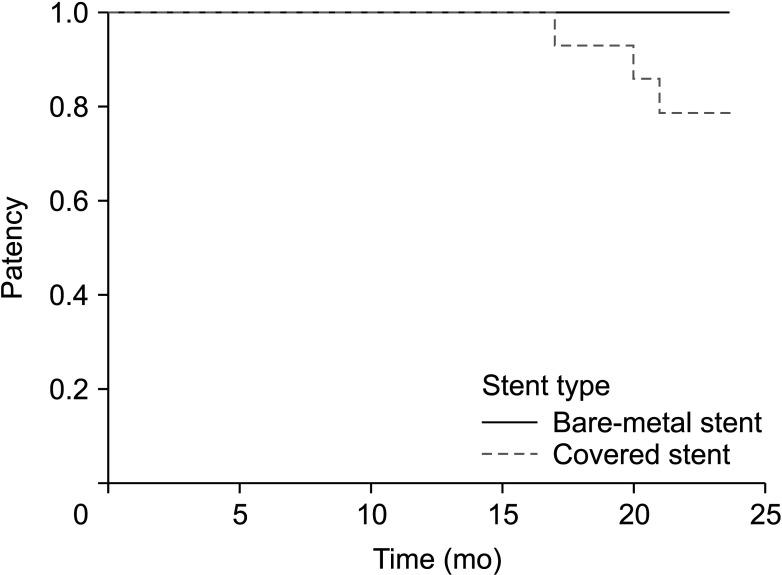Ann Surg Treat Res.
2021 Oct;101(4):247-255. 10.4174/astr.2021.101.4.247.
Midterm results of kissing stent reconstruction of the aortoiliac bifurcation
- Affiliations
-
- 1Department of Cardiovascular Surgery, Tepecik Training and Research Hospital, Izmir, Turkey
- 2Department of Cardiovascular Surgery, Bakirkoy Dr. Sadi Konuk Training and Research Hospital, Istanbul, Turkey
- KMID: 2520656
- DOI: http://doi.org/10.4174/astr.2021.101.4.247
Abstract
- Purpose
One subset of peripheral arterial disease is aortoiliac occlusive diseases (AIOD). AIOD is the term for all arterial lesions between the infrarenal distal aorta and common femoral artery. Implantation of kissing stents (KS) with covered stents (CS), bare-metal stents (BMS) is one of the endovascular treatment (ET) modalities for AIOD involving aortic bifurcation. In this study, we report the outcomes of the KS technique in infrarenal AIOD.
Methods
Between January 2014 and September 2017, 31 patients who underwent ET were treated with KS technique either with balloon-expandable BMS or balloon-expandable CS. Technical details, clinical success, complications, and patency at follow-up were documented.
Results
The majority of patients were male (77.4%), and the median age was 62 years (range, 45–78 years). All patients were classified according to the TASC II criteria. Eight patients (25.8%) were classified as TASC B. Fifteen patients (48.4%) were classified as TASC C, and 8 patients (25.8%) were classified as TASC D. These 23 patients were classified as complex AIOD group. BMS was used in 17 patients (54.8%), and CS was used in 14 patients (45.2%). Technical and clinical success was achieved in 100% of treated cases. The median follow-up was 24 months (range, 24–34 months). Primary patency rates at 12, 18, and 24 months after ET were 100%, 96.8%, and 90.3%, respectively.
Conclusion
We found that the KS technique has satisfying 24-month results, even in complex AIOD lesions, with high technical success and acceptable midterm patency.
Figure
Reference
-
1. Selvin E, Erlinger TP. Prevalence of and risk factors for peripheral arterial disease in the United States: results from the National Health and Nutrition Examinat ion Sur vey, 1999-2000. Circulation. 2004; 110:738–743. PMID: 15262830.2. Norgren L, Hiatt WR, Dormandy JA, Nehler MR, Harris KA, Fowkes FG, et al. Inter-Society Consensus for the Management of Peripheral Arterial Disease (TASC II). Eur J Vasc Endovasc Surg. 2007; 33 Suppl 1:S1–S75. PMID: 17140820.
Article3. Upchurch GR, Dimick JB, Wainess RM, Eliason JL, Henke PK, Cowan JA, et al. Diffusion of new technology in health care: the case of aorto-iliac occlusive disease. Surgery. 2004; 136:812–818. PMID: 15467666.
Article4. Goodney PP, Beck AW, Nagle J, Welch HG, Zwolak RM. National trends in lower extremity bypass surgery, endovascular interventions, and major amputations. J Vasc Surg. 2009; 50:54–60. PMID: 19481407.
Article5. Groot Jebbink E, Holewijn S, Versluis M, Grimme F, Hinnen JW, Sixt S, et al. Meta-analysis of individual patient data after kissing stent treatment for aortoiliac occlusive disease. J Endovasc Ther. 2019; 26:31–40. PMID: 30499352.
Article6. Björses K, Ivancev K, Riva L, Manjer J, Uher P, Resch T. Kissing stents in the aortic bifurcation: a valid reconstruction for aorto-iliac occlusive disease. Eur J Vasc Endovasc Surg. 2008; 36:424–431. PMID: 18692412.7. Haulon S, Mounier-Véhier C, Gaxotte V, Koussa M, Lions C, Haouari BA, et al. Percutaneous reconstruction of the aortoiliac bifurcation with the “kissing stents” technique: long-term follow-up in 106 patients. J Endovasc Ther. 2002; 9:363–368. PMID: 12096953.
Article8. Park KB, Do YS, Kim DI, Kim DK, Kim YW, Shin SW, et al. The TransAtlantic Inter Society Consensus (TASC) classification system in iliac arterial stent placement: long-term patency and clinical limitations. J Vasc Interv Radiol. 2007; 18:193–201. PMID: 17327551.9. de Vries SO, Hunink MG. Results of aortic bifurcation grafts for aortoiliac occlusive disease: a meta-analysis. J Vasc Surg. 1997; 26:558–569. PMID: 9357455.
Article10. Nyman U, Uher P, Lindh M, Lindblad B, Ivancev K. Primary stenting in infrarenal aortic occlusive disease. Cardiovasc Intervent Radiol. 2000; 23:97–108. PMID: 10795833.
Article11. Mouanoutoua M, Maddikunta R, Allaqaband S, Gupta A, Shalev Y, Tumuluri R, et al. Endovascular intervention of aortoiliac occlusive disease in high-risk patients using the kissing stents technique: long-term results. Catheter Cardiovasc Interv. 2003; 60:320–326. PMID: 14571480.
Article12. Pulli R, Dorigo W, Fargion A, Angiletta D, Azas L, Pratesi G, et al. Early and midterm results of kissing stent technique in the management of aortoiliac obstructive disease. Ann Vasc Surg. 2015; 29:543–550. PMID: 25595108.
Article13. Sixt S, Krankenberg H, Möhrle C, Kaspar M, Tübler T, Rastan A, et al. Endovascular treatment for extensive aortoiliac artery reconstruction: a single-center experience based on 1712 interventions. J Endovasc Ther. 2013; 20:64–73. PMID: 23391085.
Article14. Farb A, Sangiorgi G, Carter AJ, Walley VM, Edwards WD, Schwartz RS, et al. Pathology of acute and chronic coronary stent ing in humans. Circulation. 1999; 99:44–52. PMID: 9884378.15. AbuRahma AF, Hayes JD, Flaherty SK, Peery W. Primary iliac stenting versus transluminal angioplasty with selective stenting. J Vasc Surg. 2007; 46:965–970. PMID: 17905559.
Article16. Ozkan U, Oguzkurt L, Tercan F. Technique, complication, and long-term outcome for endovascular treatment of iliac artery occlusion. Cardiovasc Intervent Radiol. 2010; 33:18–24. PMID: 19768500.
Article17. Ichihashi S, Higashiura W, Itoh H, Sakaguchi S, Nishimine K, Kichikawa K. Long-term outcomes for systematic primary stent placement in complex iliac artery occlusive disease classified according to Trans-Atlant ic Inter-Society Consensus (TASC)-II. J Vasc Surg. 2011; 53:992–999. PMID: 21215582.18. Rzucidlo EM, Powell RJ, Zwolak RM, Fillinger MF, Walsh DB, Schermerhorn ML, et al. Early results of stent-grafting to treat diffuse aortoiliac occlusive disease. J Vasc Surg. 2003; 37:1175–1180. PMID: 12764261.
Article19. Houston JG, Bhat R, Ross R, Stonebridge PA. Long-term results after placement of aortic bifurcation self-expanding stents: 10 year mortality, stent restenosis, and distal disease progression. Cardiovasc Intervent Radiol. 2007; 30:42–47. PMID: 17122886.
Article20. Palmaz JC. Intravascular stents: tissue-stent interactions and design considerations. AJR Am J Roentgenol. 1993; 160:613–618. PMID: 8430566.
Article21. Sabri SS, Choudhri A, Orgera G, Arslan B, Turba UC, Harthun NL, et al. Outcomes of covered kissing stent placement compared with bare metal stent placement in the treatment of atherosclerotic occlusive disease at the aortic bifurcation. J Vasc Interv Radiol. 2010; 21:995–1003. PMID: 20538478.
Article22. Mwipatayi BP, Sharma S, Daneshmand A, Thomas SD, Vijayan V, Altaf N, et al. Durability of the balloon-expandable covered versus bare-metal stents in the Covered versus Balloon Expandable Stent Trial (COBEST) for the treatment of aortoiliac occlusive disease. J Vasc Surg. 2016; 64:83–94. PMID: 27131926.
Article23. Hinnen JW, Konickx MA, Meerwaldt R, Kolkert JL, van der Palen J, Huisman AB, et al. Long term results of kissing stents in the aortic bifurcation. Acta Chir Belg. 2015; 115:191–197. PMID: 26158249.
Article24. de Donato G, Bosiers M, Setacci F, Deloose K, Galzerano G, Verbist J, et al. 24-Month data from the BRAVISSIMO: a large-scale prospective registry on iliac stenting for TASC A & B and TASC C & D lesions. Ann Vasc Surg. 2015; 29:738–750. PMID: 25733220.25. Saker MB, Oppat WF, Kent SA, Ryu RK, Chrisman HB, Nemcek AA, et al. Early failure of aortoiliac kissing stents: histopathologic correlation. J Vasc Interv Radiol. 2000; 11:333–336. PMID: 10735428.
Article26. Vértes M, Juhász IZ, Nguyen TD, Veres DS, Hüttl A, Nemes B, et al. Stent protrusion >20 mm into the aorta: a new predictor for restenosis after kissing stent reconstruction of the aortoiliac bifurcation. J Endovasc Ther. 2018; 25:632–639. PMID: 30122138.27. Piffaretti G, Fargion AT, Dorigo W, Pulli R, Gattuso A, Bush RL, et al. Outcomes from the multicenter italian registry on primary endovascular treatment of aortoiliac occlusive disease. J Endovasc Ther. 2019; 26:623–632. PMID: 31331235.
Article28. Taeymans K, Groot Jebbink E, Holewijn S, Martens JM, Versluis M, Goverde PCJM, et al. Three-year outcome of the covered endovascular reconstruction of the aortic bifurcation technique for aortoiliac occlusive disease. J Vasc Surg. 2018; 67:1438–1447. PMID: 29169878.
Article29. Mwipatayi BP, Thomas S, Wong J, Temple SE, Vijayan V, Jackson M, et al. A comparison of covered vs bare expandable stents for the treatment of aortoiliac occlusive disease. J Vasc Surg. 2011; 54:1561–1570. PMID: 21906903.
Article
- Full Text Links
- Actions
-
Cited
- CITED
-
- Close
- Share
- Similar articles
-
- Fate of Asymptomatic Limb after Kissing Stents in Aortoiliac Occlusive Disease
- The Results of Self-Expandable Kissing Stents in Aortic Bifurcation
- Consecutive Jailed- and Kissing-Corsair Technique: Side Branch Protection and Dilation during Stent Implantation
- A Case of Complex Restenosis of Aortoiliac Stent Mimicking Downward Stent Migration
- Endovascular Stent Graft Repair of Multiple Tuberculous Thoracoabdominal Aneurysms



